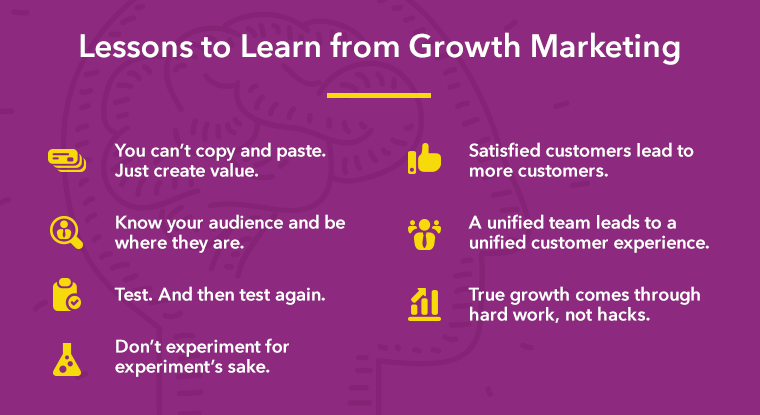In the world of marketing it can be a challenge to know if something is a fad...or here to stay.
After all, it seems like there’s always some new “proven trick” that will increase your website traffic by 3000% or the “one marketing tactic you need in [insert year here]!”
It’s also easy to take a good movement or idea and try to make it work for every company in every situation. One of those ideas? Growth marketing. We’re passionate about growth here at Simple Strat. And we believe that marketing can help your business grow in tangible ways. So the idea of growth marketing is something that intrigues and inspires us.
We’re passionate about growth here at Simple Strat. And we believe that marketing can help your business grow in tangible ways. So the idea of growth marketing is something that intrigues and inspires us.
Let’s take a deeper look at growth marketing, what it is, and some of the lessons we can learn from its popularity: things that both work and hurt.
What is growth marketing?
The idea of “growth marketing” began as startups looked to achieve big results on small budgets. They were continually experimenting, optimizing their marketing efforts, and trying new things until they found that golden ticket.

This often looked like “hacking” their way to growth and marketing success using interesting, sometimes sneaky, tactics.
Or at least that was the goal.
A classic example is Dropbox. They launched their incredibly successful referral program: Every time you invited someone to Dropbox (and they created an account), you both got extra space. This incentivized people to refer everyone they knew to Dropbox—at a very low cost to Dropbox.
Another success story was in 2004 with the launch of Gmail. They created a feeling of exclusivity by offering the email service by invite only. It started out with only a thousand influencers who were able to invite their friends. It spread like wildfire.
The key was a great product, the right product market fit, and using data to find the right tactics to make spread the product.
But there’s more to growth marketing than one home run tactic that skyrockets your business!
Most advanced definitions of growth marketing boil down to two main criteria: optimization and a full funnel approach.
Growth marketing focuses on the entire marketing funnel and lifetime value of a customer, working to accomplish growth in specific areas through data analysis, experiments and constant optimization.
How this looks practically varies company by company. Some companies will have a “growth team” separate from their marketing team. Others will have a combined team or a few members who focus on growth exclusively.
But for many who invest in growth marketing, the focus is creating a powerful experience for customers at every stage of their journey and using data to determine the best ways to do that.

Lessons we all can learn from growth marketing
While some companies still look to growth marketing as their way to quickly earn more customers and more revenue, there’s more to learn from a wider definition of the term. Whether your organization has a team focused on growth or it’s an idea you’re tossing around in your mind, there are simple lessons we can all learn from what growth marketing hopes to accomplish.
You can’t copy and paste. Just create value.
We always love a good story and growth marketing is full of them! But it’s also a good reminder that what works for one company won’t necessarily work for another. Rather than copying what another company did to power their way toward growth, just focus on your customers: getting to know them and creating value for them. While you might not always be able to have the speedy results that Dropbox or Gmail had doesn’t mean you aren’t able to build your business through valuable offers and content for your customers. Focus on that instead.

Know your audience and be where they are.
Growth marketing experiments focus on the entire experience their target audience has with their company. They know what motivates and incentivizes their customers and they target that. Rather than focusing exclusively on what makes other companies grow, focus on your customers and what they want, their goals, and their priorities!
That’s exactly what Uber did. They spent their time in the locations where their target audience was (and where hailing a taxi was a challenge!) They knew the challenges their customers faced and offered a better solution, when and where they needed it.
Test. And then test again.
The beauty of growth marketing comes in the data-driven process. It’s not about finding vanity metrics that make you look good, but it’s about using data to find unique opportunities, validate everything, and find something that multiplies growth.
Most growth marketing focuses on experimenting around one specific goal and working to find a tactic that impacts that goal. Do you want to increase your Twitter following? Website traffic? Click-through-rate? Take the time to innovate and focus your efforts on that goal, rather than spreading your efforts so thin and making it difficult to grow in any areas.
Don’t experiment for experiment’s sake.
But even though growth marketing encourages testing different tactics and strategies, the purpose of the experimentation isn’t the experiment itself. It’s to add value for your customers. By analyzing what works and what doesn’t, you can focus on the tactics that move the needle in the long run, rather than just looking for a quick win.

Satisfied customers lead to more customers.
Growth marketing’s focus on the entire funnel emphasizes the value of a great customer experience. We’ve seen this through powerful referral programs or simple Google or Yelp reviews. People talk about their great experiences, so if you can create satisfied customers, you’ll see positive results when that leads to more customers for your company.
A unified team leads to a unified customer experience.
Many growth teams span sales, marketing, and product, believing that valuable insight comes from every part of the company and that customer experience should directly impact the product or services you offer. But this can’t happen without great internal communication and feedback.
Gain insight about your target audience from different parts of your company and you’ll see the results in a unified customer experience.
True growth comes through hard work, not hacks.
Ultimately long-term growth comes through hard work, continual analysis, and smart decisions, not one hit wonders. The best tactics take that into account and use a focused, analytical approach to drive growth and build success.
Growth marketing inspires us to think outside the box about the entire customer experience and use innovative tactics to drive growth.
But when growth is the only goal, it often doesn’t last. Keep your customers first and look for ways to add value and solve their problems. That’s a long-lasting impact that you rarely can accomplish through a quick hack.

